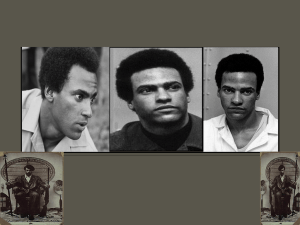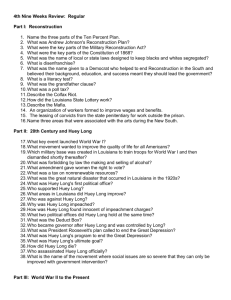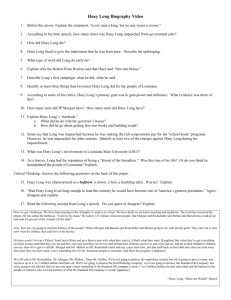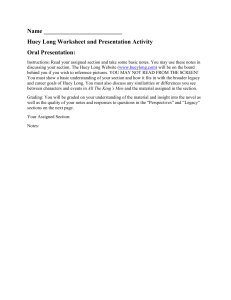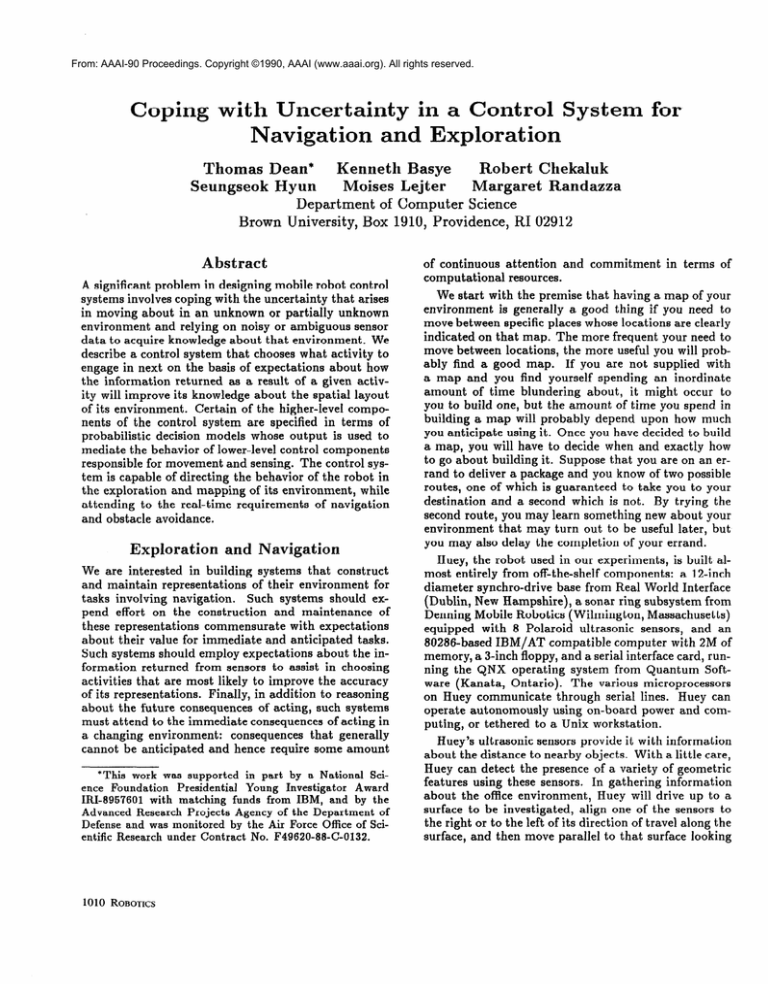
From: AAAI-90 Proceedings. Copyright ©1990, AAAI (www.aaai.org). All rights reserved.
Coping
with Uncertainty
in a Control System
Navigation and Explosat ion
for
Thomas Dean*
Kenneth Basye
Robert Chekaluk
Seungseok Hyun
Moises Lejter
Margaret Randazza
Department of Computer Science
Brown University, Box 1910, Providence, RI 02912
Abstract
A significant problem in designing mobile robot control
systems involves coping with the uncertainty that arises
in moving about in an unknown or partially unknown
environment and relying on noisy or ambiguous sensor
data to acquire knowledge about that environment. We
describe a control system that chooses what activity to
engage in next on the basis of expectations about how
the information returned as a result of a given activity will improve its knowledge about the spatial layout
of its environment. Certain of the higher-level components of the control system are specified in terms of
probabilistic decision models whose output is used to
mediate the behavior of lower-level control components
responsible for movement and sensing. The control system is capable of directing the behavior of the robot in
the exploration and mapping of its environment, while
attending to the real-time requirements of navigation
and obstacle avoidance.
Exploration
and Navigation
We are interested in building systems that construct
and maintain representations of their environment for
tasks involving navigation.
Such systems should expend effort on the construction and maintenance of
these representations commensurate with expectations
about their value for immediate and anticipated tasks.
Such systems should employ expectations about the information returned from sensors to assist in choosing
activities that are most likely to improve the accuracy
of its representations. Finally, in addition to reasoning
about the future consequences of acting, such systems
must attend to the immediate consequences of acting in
a changing environment: consequences that generally
cannot be anticipated and hence require some amount
*This work was supported in part by a National Science Foundation Presidential Young Investigator Award
IRI-8957601 with matching funds from IBM, and by the
Advanced Research Projects Agency of the Department of
Defense and was monitored by the Air Force Office of Scientific Research under Contract No. F49620-88-C-0132.
1010 ROBOTICS
of continuous attention and commitment
computational resources.
in terms of
We start with the premise that having a map of your
environment is generally a good thing if you need to
move between specific places whose locations are clearly
indicated on that map. The more frequent your need to
move between locations, the more useful you will probably find a good map. If you are not supplied with
a map and you find yourself spending an inordinate
amount of time blundering about, it might occur to
you to build one, but the amount of time you spend in
building a map will probably depend upon how much
you anticipate using it. Once you have decided to build
a map, you will have to decide when and exactly how
to go about building it. Suppose that you are on an errand to deliver a package and you know of two possible
routes, one of which is guaranteed to take you to your
destination and a second which is not. By trying the
second route, you may learn something new about your
environment that may turn out to be useful la.ter, but
you may also delay the completion of your errand.
Huey, the robot used in our experiments, is built almost entirely from off-the-shelf components: a 1%inch
diameter synchro-drive base from Real World Interface
(Dublin, New Hampshire), a sonar ring subsystem from
Denning Mobile Robotics (Wilmington, Massachusetts)
equipped with 8 Polaroid ultrasonic sensors, and an
80286-based IBM/AT compatible computer with 2M of
memory, a 3-inch floppy, and a serial interface card, running the QNX operating system from Quantum Software (Kanata, Ontario). The various microprocessors
on Huey communicate through serial lines. Huey can
operate autonomously using on-board power and computing, or tethered to a Unix workstation.
Huey’s ultrasonic sensors provide it with information
about the distance to nearby objects. With a little care,
Huey can detect the presence of a variety of geometric
features using these sensors. In gathering information
about the office environment, Huey will drive up to a
surface to be investigated, align one of the sensors to
the right or to the left of its direction of travel along the
surface, and then move parallel to that surface looking
for abrupt changes in the information returned by the
aligned sensor that would indicate some geometric feature such as a 90° corner. In doing this, Huey keeps
track of the accumulated error in its movement and the
variation in its sensor data to assign a probability to
whether or not a feature is present.
Huey has strategies for checking out many simple geometric features found in typical office environments;
we refer to these strategies as feature detectors.
The
complete set of feature detectors used by Huey and the
details concerning their implementation are described
in [Randazza, 19891. Each feature detector is realized
as a control process that directs the robot’s movement
and sensing. On the basis of the data gathered during
the execution of a given feature detector, a probability
distribution is determined for the random va.ria.ble corresponding to the proposition that the feature is present
at a specific location.
Huey is designed to explore its environment in order
to build up a. representation of that environment suitable for route planning. In the course of exploration,
Huey induces a graph that captures certain qualitative
features of its environment [Kuipers and Byun, 1988,
Levitt et al., 1987, Basye et al., 19891. In addition to detecting geometric features like corners and door jambs,
Huey is able to classify locations. In particular, Huey is
able to distinguish between corridors and places where
corridors meet or are punctuated by doors leading to
offices, labs, and storerooms. A corridor is defined as
a piece of rectangular space bounded on two sides by
uninterrupted parallel surfaces 1.5 to 2 meters apart
and bounded on the other two sides by ports indicated
by abrupt changes in one of the two parallel surfaces.
The ports signal locally distinctive places (LDPs) (after
[Kuipers and Byun, 19881) which generally correspond
to hallway junctions. Uninterrupted corridors are represented as arcs in the induced graph while junctions
are represented as vertices. Junctions are further partitioned into classes of junctions (e.g., L-shaped junctions
where two corridors meet at right angles, or T-shaped
junctions where one corridor is interrupted by a second
perpendicular corridor). Huey is given a set of junction
classes that it uses to classify and the label the locations
encountered during exploration.
In the following sections, we consider two of the main
decision processes that comprise Huey’s control system,
but first we consider briefly the overall architecture in
which these decision processes are embedded.
Planning
and Control
Huey’s control system is composed of a set of decision
processes running concurrently under a multi-tasking
prioritized operating system. There is no shared state
information; all communication is handled by interprocess message passing. Run-time process arbitration
is handled by dynamically altering the process priorities. Coordination among processes is achieved through
a
ISonarConlrollerI
IMotorControllerI
Figure 1: Huey’s Control Processes
a set of message-passing protocols.
The different processes that make up Huey’s controller are partitioned into levels (see Figure 1). For
each level, there is a corresponding arbitrator designed
to coordinate the different processes located at that
level. At Level 0, we find the processes responsible for
control of the different sensor/effecter systems on board
the mobile base. Each Level 0 process is completely independent of the other processes, so no arbitration is
needed. At Level 1, we find the processes responsible for
the low-level control of Huey. Level 1 processes are coordinated using a simple priority scheme: the obstacle
avoidance process always takes priority over the other
Level 1 processes. The activities of the feature recognition and corridor following processes are coordinated
by higher-level processes.
Currently, Huey has only one Level 2 process, the LDP
classifier, but, as we increase Huey’s capabilities, we
anticipate several additional processes on this level. At
Level 3, we find the two processes responsible for Huey’s
higher-level behaviors: the task manager in charge of
running user-specified errands, and the geographer in
charge of exploration and map building. The geographer (roughly) implements the algorithms in [Basye et
al., 19891. The task manager is a very simple route
planner. The activities of these two processes are coordinated by a Level 4 decision process that takes into
account the possible costs and benefits to be derived
from different strategies for mixing exploration and errand running. To get a better idea of how Huey handles some of its higher-level decision making, we now
describe the decision processes at Levels 2 and 4.
Classifying
Locally
Distinctive
Places
Upon exiting a corridor through a port, Huey will want
to determine what sort of LDP it has entered. If Huey
is in a well-explored portion of its environment, this
DEAN ET AL. 1011
Figure 2: LDP-classification
module’s influence diagram
determination should match Huey’s expectations as indicated in its map. If, on the other hand, Huey is in
some unknown or only partially-explored area, this determination will be used to extend the map, possibly
adding new vertices or identifying the current LDP with
existing vertices. In this section, we describe how Huey
classifies the LDPs encountered during exploration.
Let L be the set of all locally distinctive places in the
robot’s environment, C = (Cl, C’s,. . . , Cn) be a set of
equivalence classes that partitions L, and F be a set of
primitive geometric features (e.g., convex and concave
corners, flat walls). Each class in C can be characterized as a set of features in F that stand in some spatial
relationship to one another. As Huey exits a port, a
local coordinate system is set up with its origin on the
imaginary line defined by the exit port and centered in
the corridor. The space about the origin enclosing the
LDP is divided into a set of equi-angular wedges W. For
each feature/wedge pair (f, w) in F x W, we define a
specialiaed feature detector df,, that is used to determine if the current LDP satisfies the feature f at location
w in the coordinate system established upon entering
the LDP. Let D be the set of all such feature detectors
plus no-op, a pseudo-detector that results in no new
information and takes no time or effort to execute.
Huey’s LDP-classification module maintains a a proba.bilistic assessment of the hypotheses concerning the
class of the current LDP given the evidence acquired
thus far. At any given time, Huey will have tried some
number of feature detectors. Let Pt be the pool of detectors available for use at time t; Pt is just D less the
set of detectors executed up until t in classifying the
current LDP. The LDP-classification module is responsible for choosing the next feature detector to invoke
from the set Pt. It does so using a decision model cast
in terms of an influence diagram [Howard and Matheson, 19841. The details are described in [Chekaluk,
19891; in the following, we highlight the main points.
The LDP-classification module’s influence diagram includes a set of chance nodes corresponding to random
1012
ROBOTICS
variables, a decision node corresponding to actions that
the robot might take, and a vabu~ node representing the
expected utility of invoking the different feature detectors in various circumstanc&. The chance nodes include
a hypothesis variable, H, that can take on values from
C, and a set of boolean variables of the form, Xf,y, used
to represent whether or not the feature f is present at
location w. Each Xj,w is conditioned on the hypothesis H according to the distribution Pr(Xj,w ]Ci) determined by whether or not the class requires the feature
. .
at the specified location. The decision node, Pt, mdrcates the feature detectors available for use at time t,
and the value node, V, represents the utility of invoking each feature detector. V is dependent only upon
the hypothesis and decision nodes. The predecessors of
Pt are just the feature detectors invoked so far, thereby
indicating temporal precedence and informational dependence. A graphical representation of the influence
diagram is shown in Figure 2.
The utility of invoking each detector is based on (i)
the ability of the detector to discriminate among the hypotheses, (ii) the cost of deploying the detector, (iii) the
probability that the current best hypothesis is correct,
and (iv) the cost of misidentifying the LDP. The first
two are used to select from among D - (no-op) and the
last two are used to choose between the best detector
from D - {no-op) and no-op. The LDP-classification
module selects from D - (no-op),
using the function,
p : Pt x H + !J?, defined by ~(dj,~, h) =
nlDiscrim(dj,,,,)
- nzCost(dj,,
, h),
where nl and ~2 are constants used for scaling,
Co~t(djp, h) is a function of the expected time
spent in executing dj,, for an LDP of a given Class,
and Discrim(dj,, ) is the discrimination function of
[Cameron and Durrant-Whyte,
19881 adapted for our
application, and defined by
2
Pr(C;)
i=l
c
1Pr(dj+,
= vIG) - Pr(dj,W = v)I,
uao,11
where dj+ = 11 is meant to represent the proposition
that the detector dj,, returns the value ‘u. The terms in
the above formula are easily obtained. Pr(dj,, = v]C;)
is the distribution associated with the corresponding
Xj,W node, and Pr(dj,w = V) can be calculated using
Pr(dj,,
= V) = 2 Pr(df,,
i=l
= 71lCi) Pr(Ci)
The LDP-classification module evaluates the influence
diagram using Agogino and Rama.murthi’s [1988] algorithm to obtain a decision policy and an expected value
function for choosing from among D - (no-op).
The
LDP-classification module can also choose to do nothing
by selecting no-op, thereby committing to the class Ci
with the highest posterior probability given the information returned by the feature detectors invoked thus
far. The actual decision model used by Huey is somewhat more complicated than the one described here; in
particular, Huey has an additional set of chance nodes
corresponding to micro features, the set of feature detectors is more extensive than indicated here, and the
current system allows for a feature detector to be invoked multiple times.
Expected
Value of Exploration
We have experimented with several decision models for
reasoning about the expected value of exploration. In
the simple model presented in this section, we assume
that the system of junctions and corridors that make
up Huey’s environment can be registered on a grid so
that every corridor is aligned with a grid line and every junction is coincident with the intersection of two
grid lines. In the following, the set of junction types, J,
corresponds to all possible configurations of corridors
incident on the intersection of two grid lines. Intersections with at least one incident corridor correspond to
LDPs.
Since we also assume that Huey knows the dimensions of the grid (i.e., the number of z and y grid
lines), Huey can enumerate the set of possible maps
where a map corresponds to
M = (MI,
M2, . . .t M,),
an assignment of a junction type to each intersection of
grid lines. For most purposes, we can think of a map
as a labeled graph.
We restrict M by making a number of assumptions
about office buildings of the sort that Huey will find itself in (e.g., all LDPs are connected). To further restrict
M; Huey engages in an initial phase of task-driven exploration. Each task specifies a destination location in
a, y grid coordinates. Huey computes the shortest path
assuming that all intersections have as many coincident
corridors as is consistent with what is known about the
intersection and its adjacent intersections.
Huey then
follows this path, acquiring additional information as
it moves through unknown intersections until it either
finds its path blocked, in which case it recomputes the
shortest path to the goal taking into account its new
knowledge, or it reaches the goal.
Huey continues in this task-driven exploration phase
until it is likely-based
on the spatial distribution of
known locations-that
all locations have been visited
at least once. From this point on, given a task to move
to specific location, it is likely that Huey will be able
to compute a path through known territory. Huey now
faces the decision whether to take the known path or to
try an alternative path through unknown territory. In
the model considered here, Huey has to choose between
taking the shortest path through known territory, and
trying the shortest path consistent with what is known.
In the latter case, Huey will learn something new, but
it may end up taking longer to complete its task.
Let H be a random variable corresponding to the
actual configuration of the environment; H takes on
values from M. Let Js,v be a random variable corre-
Figure 3: The probabilistic
model for map building
sponding to the junction type of the intersection at the
coordinates, (2, y), in the grid; Jz,y can take on values
from the set C defined previously. Let Xj,w be as previously defined, a boolean variable corresponding the
presence of a feature at a particular position. Let S&
be a random variable corresponding to a possible sensing action taken at the coordinates, (z, y), in the grid.
Let I correspond to the set of sensing actions taken
thus far. The complete probabilistic model is shown in
Figure 3.
In our simple model, Huey has to decide between the
two alternatives, PK and Pu, corresponding to paths
through known and unknown territory.
To compute
P+flq, J+(H) is assumed to be uniform, Pr( Ja,y IH)
and J+(.& IJlo,y) are determined by the geometry,
Let
and Pr(S,,, IXjtw) is determined experimentally.
T = (Tl,Ta,...,
T,.) denote the set of all tasks corresponding to point-to-point traversals, and E( ITi 1) denote the expected number of tasks of type Ti. Let
Cost(Ti, Mj, Mk) be the time required for the task Ti
using the map Mj, given that the actual configuration
of the environment is Mk; if Mj is a subgraph of Mk,
then Cost(T;, Mj, Mk) is just the length of the shortest
path in Mjs Let T* denote Huey’s current task. For
evaluation purposes, we assume that Huey will take at
most one addition al exploratory step.
a means
To complete the decision model, we
of computing the expected value of PK and Pu. In
general, the value of a given action is the sum of the
immediate costs related to T* and the costs for expected
future tasks. Let
Futures(M;,l)
= xE(ITjI)Cost(q,
M;, M;),
j=l
where Mf = Margmax,~r
M,II)If classification is per i ect, Huey correctly classifies
any location it passes through, and ME is the minimal
DEAN ET AL. 1013
assignment consistent with what it has classified so far.
In this case, the expected value of PK is
Cost(T*,
If classification
is
5
M*, -) + Futures( -, I).
is imperfect,
Pr(Mj ]r) [Cost(T*,
the expected value of PK
M*, Mj) + Futures(Mj,
E)] .
j=l
Handling Pv is just a bit more complicated. Suppose
that Huey is contemplating exactly one sensing action
that will result in one of several possible observations
then the expected value of Pu is
01, - - - t 0,,
2
Pr(Mj ]E) Cost(T*‘,
M*, Mj) +
j=l
73
C
731
Pr(Oi) >:
i=l
Pr(Mj ]Oi, &)Futures(lClj,
[Oi, r])
j=l
where T*’ is a modification of T* that accounts for the
proposed exploratory sensing action.
We use Jensen’s [1989] variation on Lauritxen and
Spiegelhalter’s [1988] algorithm to evaluate the network
shown in Figure 3. The time required for evaluation
is determined by the size of the sample spaces for the
individual random variables and the connectivity of the
network used to specify the decision model. In the case
of a singly-connected’ network, the cost of computation
is polynomial in the number of nodes and the size of the
largest sample space-generally
the space of possible
maps. The network shown in Figure 3 would be singlyconnected if each feature, Xf,w, had at most one parent
corresponding to a junction, Jm,y; a network of this form
with 100 possible maps can be evaluated in about 10
seconds, assuming an 8 x 8 grid.
In the case of a multiply-connected network, the cost
of computation is a function of the product of the sixes
of the sample spaces for the nodes in the largest clique of
the graph formed by triangulating the DAG corresponding to the original network. By making use of the information gathered in the initial exploratory phase, Huey
is able to reduce the connectivity of the network used
to encode the decision model. The multiply-connected
networks that Huey currently uses have around 50 possible maps, and require on the order of a few minutes
to evaluate.
The space of possible maps chosen may not include
the map correspo&mg
to the actual configuration of
the environment.
To handle such possible omissions.
we add a special value, I, to the sample space for H,
and make all of the Pr( Jz,ar ]I) entries in the conditional
‘A network is said to be singly-connected if there is at
most one directed path between any two nodes; otherwise,
it is said to be multiply connected [Pearl, 19881.
1014 ROBOTICS
probability tables l/a where s is the number of junction types. If Huey ever detects that ME = I, then
it assumes that it has excluded the real map, and dynamically adjusts its decision model by computing a
new sample space for H guided by the results of the
exploratory actions taken thus far.
Designing
Robot
Control
Systems
Our approach to designing Huey’s control system is
outlined as follows. We begin by considering Huey’s
overall decision problem, determining an optimal decision procedure according to a precisely stated decisiontheoretic criteria, neglecting computational costs. We
use an influence diagram to represent the underlying decision model and define the optimal procedure in terms
of evaluating this model.
Huey’s overall decision problem involves several component problems associated with specific classes of
events occurring in the environment. These component
decision problems include what action to take when approached by an unexpected object in a corridor, what
sensor action to take next when classifying a junction,
and what path to take in combining exploration and
task execution. Each of these problems is recurrent.
Problems involving what sensor action to take in
classification or what path to take in navigation are
predictably recurrent. For instance, during classification each sensor action takes about thirty seconds to
a minute, so the robot has that amount of time to
decide what the next action should be if it wishes to
avoid standing idle lost in computation. The frequency
with which choices concerning what path to take occur
is dependent on how long Huey takes to traverse the
corridor on route to the next LDP. With the current
mobile platform operating in the halls of the computer
science department, moving between two consecutive
LDPs takes about four minutes. The problem of deciding what to do when approached by an unexpected object occurs unpredictably, and the time between when
the approaching object is detected and when the robot
must react to avoid a collision is on the order of a few
seconds.
By making various (in)dependence assumptions and
eliminating noncritical variables from the overall complex decision problem, we are able to decompose the
globally optimal decision problem into sets of simpler
component decision problems. Each of the sets of component problems are solved by a separate module. The
computations carried out by these modules are optimized using a variety of techniques to take advantage of the expected time available for decision making
[Kanazawa and Dean, 19891. The different decision procedures communicate by passing probability distributions back and forth. For instance, the module responsible for making decisions regarding exploration and the
module responsible for classifying LDPs pass back and
forth distributions regarding the junction types of LDPs.
Conclusions
and Related
Work
The original designs for Huey’s control system were influenced by the design of the Hilare robot [Chatila and
Laumond, 19851. The lower-levels of the control system
rely little upon the existence of a global clock and adhere for the most part to the specifications of Brooks’
subsumption architecture [Brooks, 19861. Our use of influence diagrams and Bayesian decision theory was inspired by recent work on decision-theoretic control for
visual interpretation and sensor placement [Cameron
and Durrant-Whyte,
1988, Hager, 1988, Levitt et al.,
19881. The design of the geographer module was based
on the work of Kuipers [Kuipers and Byun, 19881 and
Levitt [Levitt et al., 19871 on learning maps of largescale space, and our own extensions to handle uncertainty [Basye et al., 19891. The design of the module responsible for coordinating exploration and errand running was based on an application of information value
theory [Howard, 19661.
Huey’s control system combines high-level decision
masking with low-level control and sensor interpretation to provide for navigation, real-time obstacle avoidance, and exploration in an unfamiliar environment.
The basic controller handles multiple asynchronous processes communicating via simple message-passing protocols. The architecture supports a variety of arbitration schemes from fixed-priority processor scheduling
to decision-theoretic
control. This paper emphasizes
two decision processes: one responsible for reasoning
about the uncertainty inherent in dealing with noisy
and ambiguous sensor data, and a second responsible
for assessing the expected value of various exploratory
actions. Our basic approach to designing robot control
systems involves constructing a decision model for the
overall problem and then decomposing it into component models guided by the time criticality of the associated decision problems.
References
[Agogino and Ramamurthi, 19881 A. M. Agogino and
Real-time
influence diagrams
K. Ramamurthi.
for monitoring and controlling mechanical systems.
Technical Report Technical Report, Department of
University of California,
Mechanical Engineering,
Berkeley, 1988.
[Basye et al., 19891 K enneth Basye, Thomas Dean, and
Jeffrey Scott Vitter. Coping with uncertainty in map
learning. In Proceedings IJCAI 11, pages 663-668.
IJCAI, 1989.
[Brooks, 19861 Rodney A. Brooks.
A robust layered
control system for a mobile robot. IEEE Journal of
Robotics and Automation,
2~14-23, 1986.
Cameron
[Cameron and Durrant-Whyte,
19881 Alec
and Hugh F. Durrant-Whyte.
A bayesian approach
to optimal sensor placement. Technical report, Oxford University Robotics Research Group, 1988.
[Chatila and Laumond, 19851 R. Chatila
and J.-P.
Laumond. Position referencing and consistent world
modeling on mobile robots. In IEEE International
Conference on Robotics and Automation, pages 138145, March 1985.
[Chekaluk, 19891 Robert A. Chekaluk. Using influence
diagrams in recognizing locally-distinctive
places.
M.Sc. Thesis, Brown University, 1989.
[Hager, 19881 Gregory D. Hager. Active reduction of
uncertainty in multi-sensor systems. Ph.D. Thesis,
University of Pennsylvania, Department of Computer
and Information Science, 1988.
[Howard and Matheson, 19841 Ronald A. Howard and
Influence diagrams.
In
James E. Matheson.
Ronald A. Howard and James E. Matheson, editors,
The Principles
and Appbications of Decision Analysis. Strategic Decisions Group, Menlo Park, CA
94025, 1984.
[Howard, 19661 Ronald A. Howard. Information value
theory. IEEE Transactions on Systems Science and
Cybernetics, 2( 1):22-26, 1966.
[Jensen, 19891 Finn V. Jensen. Bayesian updating in
recursive graphical models by local computations.
Technical Report R-89-15, Institute for Electronic
Systems, Department of Mathematics and Computer
Science, University of Aalborg, 1989.
[Kanazawa and Dean, 19891 Keiji
Kanazawa
and
Thomas Dean. A model for projection and action. In
Proceedings IJCAI 11, pages 985-990. IJCAI, 1989.
[Kuipers and Byun, 19881 Benjamin J. Kuipers and
Yung-Tai Byun. A robust, qualitative method for
In Proceedings AAAI-88,
robot spatial reasoning.
pages 774-779. AAAI, 1988.
[Lauritzen and Spiegelhalter, 19881 Stephen
L. Lauritzen and David J. Spiegelhalter.
Local computations with probabilities on graphical structures and
their application to expert systems. Journal of the
1988.
Royal Statistical Society, 50(2):157-194,
[Levitt et al., 19871 Tod S. Levitt, Daryl T. Lawton,
David M. Chelberg, and Philip C. Nelson. Qualitative landmark-based path planning and following. In
Proceedings AAAI-87, pages 689-694. AAAI, 1987.
[Levitt et al., 19881 Tod Levitt, Thomas Binford, Gil
Ettinger, and Patrice Gelband.
Utility-based control for computer vision. In Proceedings of the 1988
Worhshop on Uncertainty in Artificial Intelligence,
1988.
[Pearl, 19881 Judea Pearl. Probabilistic Reasoning in
Intelligent Systems: Networhs of Plausible Inference.
Morgan-Kaufman, Los Altos, California, 1988.
[Randazza, 19891 Margaret J. Randazza. The feature
recognition module of the ldp system for the robot
huey. M.Sc. Thesis, Brown University, 1989.
DEAN ET AL.
1015

